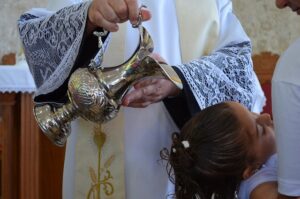Oneness theology states that the Father was in the Son and that the person of Jesus was also the person of the Father. Of course, when we see instances in the Bible where Jesus prays to the Father, we naturally wonder how this can be if they are the same person. But, according to Oneness theology, Jesus was praying to the Father, the true divinity, though it was Jesus the man who was praying. But, how can this be? Was Jesus praying to Himself (since God is only one person in Oneness theology) and making it appear that He was praying to someone else?
Oneness theology correctly states that Jesus has two natures. He was both God and man while He walked this earth.1 But it states that the human part of Jesus was praying to the divine essence of God as the Father. What they do is divide Jesus into two parts and have the human nature address the divine nature–which was somehow in heaven while Jesus, who has two natures, was on earth.
The problem with this is that it threatens the incarnation of the Word made flesh as a complete and single person. Jesus was both God and man in one person. He had a will. He ate. He slept, etc. He was a man. He needed to be a human in order to bear the sins of people. He needed to be God in order to offer a sacrifice to God the Father sufficient to cleanse us of our sins. No mere man could do this. But the fact is, Jesus was one person–and still is.2 Jesus was both God and man at the same time in the form of a single person.
The Oneness explanation risks the error of Nestorianism.3 Nowhere in the Bible does it state that Jesus was two persons. Rather, we find scriptures where Jesus refers to Himself as “I” and “Me” and “mine” not “us” or “our.” The Oneness position is simply in error.
Jesus was not praying to Himself. We see in Scripture, Jesus praying to the Father (John 17). We see Him addressing another person who is called God. We see Jesus saying, “Not my will, but your will be done” (Luke 22:42) when he addressed God the Father. In other words, they had separate wills–at the same time. He was not praying to himself or an extension of himself or of a part of himself. He was praying to the person of the Father.
Furthermore, according to Oneness theology, Jesus would have had to exist at the same time as the Father if Jesus the man was praying to the Father. If this is so and Jesus was addressing the Father, then we have two simultaneous persons–which is false. But in Oneness theology, this is a problem since God is only one person who occupies modes. How then could the “mode” of the Father and the “mode” of the Son be in existence at the same time if Oneness theology is correct? They cannot, which is another reason why Oneness theology is wrong.
References
| 1↑ | Actually, Jesus is still God and man. Col. 2:9 states that in Him dwells all the fullness of the Godhead bodily. Note, the verse says “dwells,” not dwelt. Dwells is in the present tense, not the past. Therefore, in Jesus, right now, dwells the fullness of the Godhead. |
|---|---|
| 2↑ | See my article Oneness and the word “person” that deals with the nature of personhood. |
| 3↑ | This heresy is attributed to Nestorius who was a preacher at Antioch and the Bishop of Constantinople around A.D. 428. However, Nestorius did not preach that Jesus was two persons in one body, but his name has become attached to this error which stated that Jesus was two separate persons: a human person and a divine person in the form of one man. |






